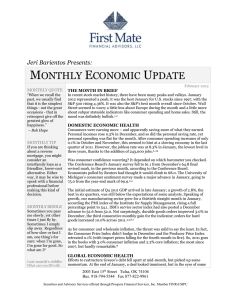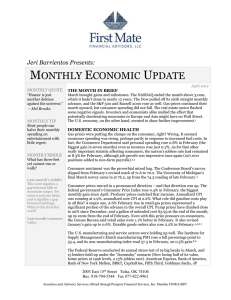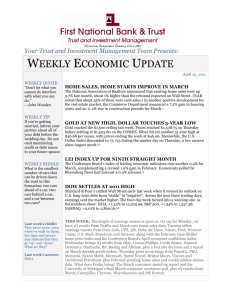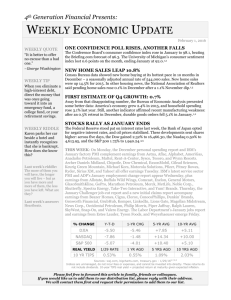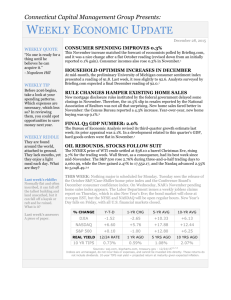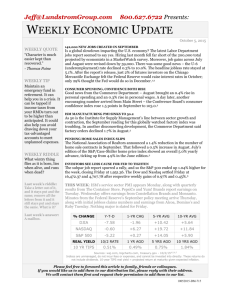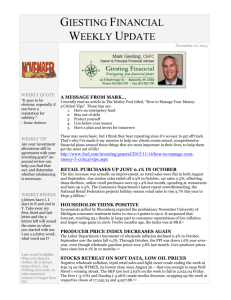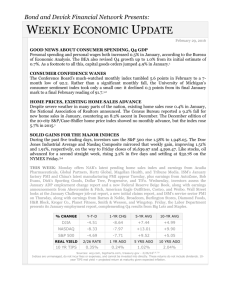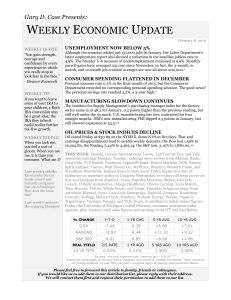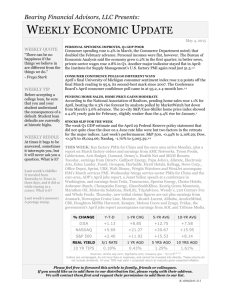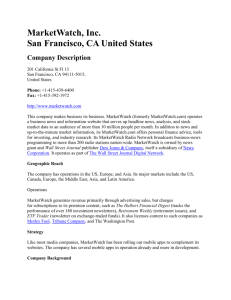Monthly Economic Update for February 2011
advertisement
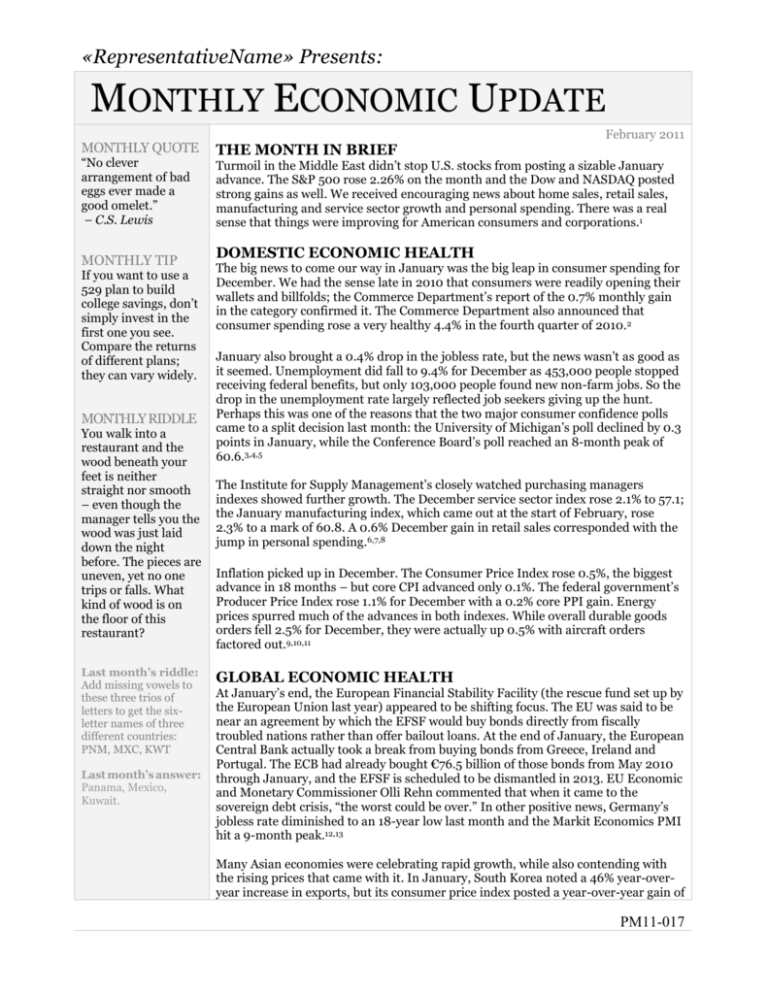
«RepresentativeName» Presents: MONTHLY ECONOMIC UPDATE MONTHLY QUOTE “No clever arrangement of bad eggs ever made a good omelet.” – C.S. Lewis MONTHLY TIP If you want to use a 529 plan to build college savings, don’t simply invest in the first one you see. Compare the returns of different plans; they can vary widely. MONTHLY RIDDLE You walk into a restaurant and the wood beneath your feet is neither straight nor smooth – even though the manager tells you the wood was just laid down the night before. The pieces are uneven, yet no one trips or falls. What kind of wood is on the floor of this restaurant? Last month’s riddle: Add missing vowels to these three trios of letters to get the sixletter names of three different countries: PNM, MXC, KWT Last month’s answer: Panama, Mexico, Kuwait. February 2011 THE MONTH IN BRIEF Turmoil in the Middle East didn’t stop U.S. stocks from posting a sizable January advance. The S&P 500 rose 2.26% on the month and the Dow and NASDAQ posted strong gains as well. We received encouraging news about home sales, retail sales, manufacturing and service sector growth and personal spending. There was a real sense that things were improving for American consumers and corporations.1 DOMESTIC ECONOMIC HEALTH The big news to come our way in January was the big leap in consumer spending for December. We had the sense late in 2010 that consumers were readily opening their wallets and billfolds; the Commerce Department’s report of the 0.7% monthly gain in the category confirmed it. The Commerce Department also announced that consumer spending rose a very healthy 4.4% in the fourth quarter of 2010.2 January also brought a 0.4% drop in the jobless rate, but the news wasn’t as good as it seemed. Unemployment did fall to 9.4% for December as 453,000 people stopped receiving federal benefits, but only 103,000 people found new non-farm jobs. So the drop in the unemployment rate largely reflected job seekers giving up the hunt. Perhaps this was one of the reasons that the two major consumer confidence polls came to a split decision last month: the University of Michigan’s poll declined by 0.3 points in January, while the Conference Board’s poll reached an 8-month peak of 60.6.3,4,5 The Institute for Supply Management’s closely watched purchasing managers indexes showed further growth. The December service sector index rose 2.1% to 57.1; the January manufacturing index, which came out at the start of February, rose 2.3% to a mark of 60.8. A 0.6% December gain in retail sales corresponded with the jump in personal spending.6,7,8 Inflation picked up in December. The Consumer Price Index rose 0.5%, the biggest advance in 18 months – but core CPI advanced only 0.1%. The federal government’s Producer Price Index rose 1.1% for December with a 0.2% core PPI gain. Energy prices spurred much of the advances in both indexes. While overall durable goods orders fell 2.5% for December, they were actually up 0.5% with aircraft orders factored out.9,10,11 GLOBAL ECONOMIC HEALTH At January’s end, the European Financial Stability Facility (the rescue fund set up by the European Union last year) appeared to be shifting focus. The EU was said to be near an agreement by which the EFSF would buy bonds directly from fiscally troubled nations rather than offer bailout loans. At the end of January, the European Central Bank actually took a break from buying bonds from Greece, Ireland and Portugal. The ECB had already bought €76.5 billion of those bonds from May 2010 through January, and the EFSF is scheduled to be dismantled in 2013. EU Economic and Monetary Commissioner Olli Rehn commented that when it came to the sovereign debt crisis, “the worst could be over.” In other positive news, Germany’s jobless rate diminished to an 18-year low last month and the Markit Economics PMI hit a 9-month peak.12,13 Many Asian economies were celebrating rapid growth, while also contending with the rising prices that came with it. In January, South Korea noted a 46% year-overyear increase in exports, but its consumer price index posted a year-over-year gain of PM11-017 4.1% (the year-over-year gain had been 3.5% in December). Indonesia was facing 7% inflation. A hint of cooling came from China, where the China Federation of Logistics and Purchasing index fell to 52.9 from 53.9 a month earlier. Japan actually had its credit rating downgraded by Standard & Poor’s.14 WORLD MARKETS Call it a relief rally, call it renewed optimism: many European indices did well last month, even those in fiscally troubled countries. The German DAX rose 2.2% and the French CAC 40 advanced 5.4%. The Dow Jones Stoxx 600 was up 1.5% last month, putting it up 7.0% across December and January. Spain’s Ibex rebounded 10.0% in January while the benchmark indices of Greece and Italy respectively rose 12.7% and 9.4% for the month. Notable January losers included the FTSE 100 in Great Britain (-0.6%) and the Sensex in India, which suffered a correction (-10.6%) thanks to pessimism over renewed inflation and rising interest rates. At the end of the month, it had fallen 12.4% from November highs. The MSCI World Index rose 2.19% last month while the MSCI Emerging Markets index fell 2.81% (measuring performance in U.S. dollar terms).15,16,17,18 COMMODITIES MARKETS Gold did poorly, oil did decently, and tin and cotton did amazingly well. Gold futures fell 6.1% last month, the first monthly loss for the precious metal since July 2010. In fact, it was gold’s poorest month since December 2009 and its poorest January since 1997. Silver also took a hit as investors turned back toward stocks and funds – it fell 8.9% last month. However, palladium was up 2.1% in January (for a 7-month winning streak) and platinum prices rose 1.3%. Tin prices rose 10.2% on the month, and copper pushed toward an all-time.19,20,21 Elsewhere, crude oil pulled off a 0.9% gain to get to $92.19 per barrel at the close on January 31. Cotton soared 16.0% and wheat prices gained 5.9% in January. The U.S. Dollar Index lost 1.5% for the month.19,22,23 REAL ESTATE New and existing home sales continued rebounding. Residential resales were up 12.3% for December, according to the National Association of Realtors. While the median sale price fell 1.0%, the excess inventory was also reduced to 8.1 months of supply compared to 9.5 months in December. The NAR also said pending home sales were up 2.0% in December – not quite the 4.5% gain analysts had expected, but still nice. As for new home sales, the Census Bureau noted that they jumped 17.5% in December. (Sales of new and existing homes were still respectively down 7.6% and 4.2% from a year ago.)24,25 Back on December 30, Freddie Mac found average interest rates on 30-year FRMs at 4.86%, 15-year FRMs at 4.20%, 5-year ARMs at 3.77%, and 1-year ARMs at 3.26%. By January 27, those rates had declined or held steady as follows: 30-year FRMs, 4.80%; 15-year FRMs, 4.09%; 5-year ARMs; 3.70%; 1-year ARMs, 3.26%.26,27 LOOKING BACK…LOOKING FORWARD The S&P 500 recorded its first positive January since 2007 and its best January percentage climb since 2006. The DJIA had its best January in 14 years. At the end of the month, this was how things looked.1 % CHANGE Y-T-D 1-MO CHG 1-YR CHG 10-YR AVG DJIA +2.72 +2.72 +16.75 +0.92 NASDAQ +1.78 +1.78 +24.36 -0.26 S&P 500 +2.26 +2.26 +18.08 -0.58 1/31 RATE 1 YR AGO 5 YRS AGO 10 YRS AGO 1.08% 1.29% 2.00% 3.52% REAL YIELD 10 YR TIPS PM11-017 Sources: online.wsj.com, bigcharts.com, treasury.gov, treasurydirect.gov - 1/31/111,28,29,30 Indices are unmanaged, do not incur fees or expenses, and cannot be invested into directly. These returns do not include dividends. While Wall Street kept a close eye on the situation in Egypt at the end of January and the start of February, it wound up paying more attention to domestic economic indicators and earnings reports – the DJIA suffered only one triple-digit hit from the crisis. If stocks can suddenly navigate around a major geopolitical event with such ease, will that bode well for the rest of the year? While past performance is no barometer of future success, the historical data is encouraging: when the S&P 500 has posted a January gain, it has registered a yearly gain 81% of the time since 1928 (with an average yearly advance of 12.91%). The mood was more bullish than bearish at the beginning of February, with the Dow topping 12,000, the NASDAQ over 2,700 and the S&P 500 over 1,300.31 UPCOMING ECONOMIC RELEASES: Across the balance of February, we will get reports and releases concerning the January unemployment rate (2/4), December wholesale inventories (2/10), the first University of Michigan February assessment of consumer sentiment (2/11), January retail sales and December business inventories (2/15), January’s PPI, industrial output and housing starts (2/16), January’s CPI and Conference Board LEI (2/17), December’s Case-Shiller home price index plus the Conference Board’s look at consumer confidence in January (2/22), January existing home sales (2/23), January new home sales and durable goods orders (2/24), a final look at consumer sentiment in February from the University of Michigan (2/25), and January consumer spending and pending home sales (2/28). Please feel free to forward this article to family, friends or colleagues. If you would like us to add them to our distribution list, please reply with their address. We will contact them first and request their permission to add them to our list. «RepresentativeDisclosure» This material was prepared by Peter Montoya Inc., and does not necessarily represent the views of the presenting party, nor their affiliates. This information should not be construed as investment, tax or legal advice. The Dow Jones Industrial Average is a priceweighted index of 30 actively traded blue-chip stocks. The NASDAQ Composite Index is an unmanaged, market-weighted index of all over-the-counter common stocks traded on the National Association of Securities Dealers Automated Quotation System. The Standard & Poor's 500 (S&P 500) is an unmanaged group of securities considered to be representative of the stock market in general. It is not possible to invest directly in an index. NYSE Group, Inc. (NYSE:NYX) operates two securities exchanges: the New York Stock Exchange (the “NYSE”) and NYSE Arca (formerly known as the Archipelago Exchange, or ArcaEx®, and the Pacific Exchange). NYSE Group is a leading provider of securities listing, trading and market data products and services. The New York Mercantile Exchange, Inc. (NYMEX) is the world's largest physical commodity futures exchange and the preeminent trading forum for energy and precious metals, with trading conducted through two divisions – the NYMEX Division, home to the energy, platinum, and palladium markets, and the COMEX Division, on which all other metals trade. The DAX 30 is a Blue Chip stock market index consisting of the 30 major German companies trading on the Frankfurt Stock Exchange. The CAC-40 Index is a narrow-based, modified capitalization-weighted index of 40 companies listed on the Paris Bourse. With a fixed number of 600 components, the STOXX Europe 600 Index represents large, mid and small capitalisation companies across 18 countries of the European region. The IBEX 35 is the benchmark stock market index of the Bolsa de Madrid, Spain's principal stock exchange. The Athens Stock Exchange General Index is a capitalization-weighted index of Greek stocks listed on the Athens Stock Exchange. The FTSE MIB is the primary benchmark Index for the Italian equity markets. Capturing approximately 80% of the domestic market capitalization, the Index is comprised of highly liquid, leading companies across ICB sectors in Italy. The FTSE 100 Index is a share index of the 100 most highly capitalized companies listed on the London Stock Exchange. The BSE Sensex or Bombay Stock Exchange Sensitive Index is a value-weighted index composed of 30 stocks that started January 1, 1986. The MSCI World Index is a free-float weighted equity index that includes developed world markets, and does not include emerging markets. The MSCI Emerging Markets Index is a float-adjusted market capitalization index consisting of indices in more than 25 emerging economies. The US Dollar Index measures the performance of the U.S. dollar against a basket of six currencies. Additional risks are associated with international investing, such as currency fluctuations, political and economic instability and differences in accounting standards. All information is believed to be from reliable sources; however we make no representation as to its completeness or accuracy. All economic and performance data is historical and not indicative of future results. Market indices discussed are unmanaged. Investors cannot invest in unmanaged indices. The publisher is not engaged in rendering legal, accounting or other professional services. If assistance is needed, the reader is advised to engage the services of a competent professional. Citations. 1 - blogs.wsj.com/marketbeat/2011/01/31/data-points-us-markets-342/ [1/31/11] 2 - marketwatch.com/story/us-consumer-spending-picks-up-in-december-2011-01-31 [1/31/11] 3 - blogs.forbes.com/johndobosz/2011/01/07/the-harsh-reality-of-the-falling-unemployment-rate/ [1/7/11] 4 - latimesblogs.latimes.com/money_co/2011/01/consumer-confidence-index-rises-job-market-outlook.html [1/25/11] 5 - marketwatch.com/story/us-consumers-sentiment-dips-in-january-2011-01-28 [1/28/11] 6 - ism.ws/ISMReport/NonMfgROB.cfm?navItemNumber=12943 [1/5/11] PM11-017 7 - ism.ws/ISMReport/MfgROB.cfm [2/1/11] 8 - marketwatch.com/story/us-retail-sales-climb-06-in-december-2011-01-14 [1/14/11] 9 - bls.gov/news.release/cpi.nr0.htm [1/14/11] 10 - theatlantic.com/business/archive/2011/01/consumer-price-inflation-jumps-05-in-december/69567/ [1/14/11] 11 - abcnews.go.com/Business/wireStory?id=12779327 [1/27/11] 12 - bloomberg.com/news/2011-02-01/eu-said-to-near-agreement-on-rescue-fund-buying-debt-in-private-placements.html [2/1/11] 13 - bloomberg.com/news/2011-02-01/european-manufacturing-growth-accelerated-in-january.html [2/1/11] 14 - nytimes.com/2011/02/02/business/global/02asiaecon.html [2/2/11] 15 - blogs.wsj.com/marketbeat/2011/01/31/dont-look-now-but-european-stocks-have-been-soaring/ [1/31/11] 16 - blogs.wsj.com/marketbeat/2011/01/31/data-points-europe-120/ [1/31/11] 17 - community.nasdaq.com/News/2011-02/mumbai-has-the-worst-month-since-the-crash-now-what.aspx [1/31/11] 18 - mscibarra.com/products/indices/international_equity_indices/gimi/stdindex/performance.html [1/31/11] 19 - blogs.wsj.com/marketbeat/2011/01/31/data-points-energy-metals-450/ [1/31/11] 20 - blogs.wsj.com/marketbeat/2011/01/31/who-knew-tin-prices-surge-in-january/ [1/31/11] 21 - bloomberg.com/news/2011-01-31/gold-caps-worst-start-to-a-year-since-1997-as-investment-ebbs.html [1/31/11] 22 - bloomberg.com/news/2011-01-31/u-s-commodities-raw-materials-cap-longest-rally-since-2000.html [1/31/11] 23 - online.wsj.com/mdc/public/npage/2_3051.html?mod=mdc_curr_dtabnk&symb=DXY [1/31/11] 24 - marketwatch.com/story/existing-home-sales-jump-12-in-december-2011-01-20?dist=beforebell [1/20/11] 25 - thestreet.com/print/story/10987245.html [1/27/11] 26 - freddiemac.com/pmms/ [2/2/11] 27 - freddiemac.com/pmms/index.html?year=2010 [2/2/11] 28 - bigcharts.marketwatch.com/historical/default.asp?detect=1&symbol=DJIA&close_date=2%2F1%2F10&x=0&y=0 [1/31/11] 28 - bigcharts.marketwatch.com/historical/default.asp?detect=1&symbol=COMP&close_date=2%2F1%2F10&x=0&y=0 [1/31/11] 28 - bigcharts.marketwatch.com/historical/default.asp?detect=1&symbol=SPX&close_date=1%2F31%2F06&x=0&y=0 [1/31/11] 28 - bigcharts.marketwatch.com/historical/default.asp?detect=1&symbol=DJIA&close_date=1%2F31%2F01&x=0&y=0 [1/31/11] 28 - bigcharts.marketwatch.com/historical/default.asp?detect=1&symbol=COMP&close_date=1%2F31%2F01&x=0&y=0 [1/31/11] 28 - bigcharts.marketwatch.com/historical/default.asp?detect=1&symbol=SPX&close_date=1%2F31%2F01&x=0&y=0 [1/31/11] 29 - treasury.gov/resource-center/data-chart-center/interest-rates/Pages/TextView.aspx?data=realyieldAll [2/2/11] 30 - treasurydirect.gov/instit/annceresult/press/preanre/2001/ofm11001.pdf [1/10/01] 31 - cnbc.com/id/41369435 [2/2/11] 32 - montoyaregistry.com/Financial-Market.aspx?financial-market=the-road-to-college&category=29 [2/2/11] PM11-017
